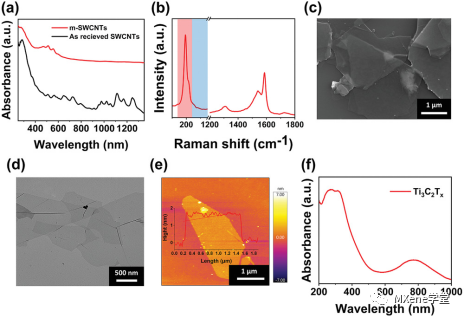
hotline:
17715390137
Tel/Wechat:
18101240246 (Technology)
0512-68565571
Email:mxenes@163.com (Sales Engineer)bkxc.bonnie@gmail.com
Scan the code to follow or search the official account on WeChat:
2D Materials Fronrier After paying attention,
click on the lower right corner to contact us,
Enter enterprise WeChat.
Professional Services Online

background
Organic inorganic hybrid perovskite solar cells (PSCs) have attracted extensive attention in the scientific and industrial fields due to their easy fabrication, low cost and excellent photovoltaic (PV) characteristics. The incorporation of 2D mxene into the electron transport layer (ETL) of perovskite solar cells has been proved to be useful for manufacturing efficient photovoltaic devices. However, the preparation environment of ETL leads to the degradation of the electrical properties of mxene due to oxidation.
Full text guide
In view of this, Professor Joseph G. shapter of the University of Queensland, Australia, and others used the mxene CNTs hybrid as the interlayer between the SnO2 layer and the perovskite layer of perovskite solar cells. First, carbon nanotubes (m-SWCNT) were obtained by column gel chromatography. By optimizing the ratio of mxene to m-swcnt, the best device performance can be obtained. The results show that the hybrid of mxene and m-swcnt can effectively improve the charge dynamics of ETL / perovskite. Specifically, 2:1 w / w mxene / m-swcnts significantly enhanced the charge extraction at the SnO2 / perovskite interface, providing 21.42% power conversion efficiency (PCE), and the fill factor increased sharply from ≈ 0.69 to ≈ 0.80 (FF). The results of related papers are entitled "1d-2d collaborative mxene nanotubes hybrids for efficient perovskite solar cells" and published on small on July 2, 2021.

Fig. 1 shows: a) the optical absorption spectrum of SWNTs before and after the separation process. b) Raman spectra of m-swcnt-rich samples were studied. c) SEM, d) tem and E) AFM images of layered mxene films. f) UV Vis spectra of mxene solution.

Fig. 2 shows: a) the colored SEM image of mxene / m-swcnts mixture. b) The Raman spectra of mxene, m-swcnts and mxene / m-swcnts mixtures were studied. Raman mapping reveals the distribution of C) mxene and (d) SWCNT in the mixture collected by 532 nm laser. The XPS spectra of fresh mxene film and ultraviolet ozone treated mxene film (E) and high resolution XPS spectra (F-G).

Figure 3 shows: a) device structure diagram, showing the introduction of interface SnO2 / CNT layer between ITO and perovskite. b) SEM images of the cross section of the whole device. Top view SEM images of perovskite films spin coated on C) bare SnO2, d) mxene, e) m-swcnt and F) mxene / m-swcnt (2:1).

Figure 4 shows the statistical distribution of a) JSC, b) FF, c) VOC and D) PCE of solar cells fabricated with different mxene / m-swcnt interface layers.

Figure 5 shows a) J-V curves and b) EQE spectra of devices based on different mxene / m-swcnts composites.

Fig. 6 shows: a) UV Vis absorption spectra of SnO2 films with different interface layers. b) PL and C) TRPL decay spectra of perovskite films on ITO / SnO2 / perovskite, ITO / SnO2 / mxene / perovskite, ITO / SnO2 / m-swcnts / perovskite and ITO / SnO2 / mxene: m-swcnts (2:1) / perovskite devices. d) EIS of PSC assembled with different interface layers. The illustration shows the equivalent circuit module for EIS fitting.

Figure 7 shows: a) J-V characteristic curves of reference and mxene / m-swcnt based devices measured in forward and reverse scanning directions. b) The normalized efficiency of devices with and without mxene nanotube mixed interface layer is investigated.
summary
This study shows that the PV performance of PSC can be improved by depositing mxene and the optimal number of m-swcnts on SnO2 layer. The results of SEM, PL, TRPL and EIS show that the mixed interface layer of mxene / m-swcnts can reduce the defect density at the interface between SnO2 and perovskite, thus reducing the trap density and improving the charge extraction and transport. The PSCs fabricated with mxene / m-swcnt (2:1 w / W) show more than 21% PCE, and FF is close to 0.80. This work shows that the solution treated mxene / m-swcnts hybrid system is a simple and effective way to achieve efficient PSC.
This information is from the Internet for academic exchange only. If there is any infringement, please contact us to delete it immediately

| Reminder: Beijing Beike New Material Technology Co., Ltd. supplies products only for scientific research, not for humans |
| All rights reserved © 2019 beijing beike new material Technology Co., Ltd 京ICP备16054715-2号 |